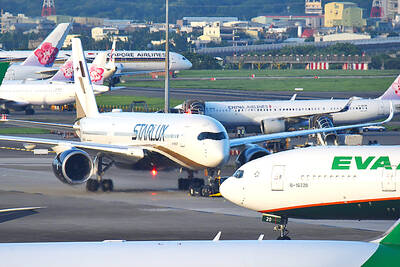Taiwan’s semiconductor industry could maintain its global lead for at least the next eight to 10 years, an analyst said on Tuesday, while an executive urged the government to ensure research security and to develop a “grand strategy” with changing supply chains in mind.
At a forum called “Taiwan in the Era of Techno-Geopolitics” in Taipei hosted by the think tank Research Institute for Democracy, Society and Emerging Technology (DSET), analyst Ray Yang (楊瑞臨) said he believes the nation’s semiconductor industry would maintain its competitive edge for another eight to 10 years.
However, while Taiwan’s lead in the commercial sectors of the industry — including manufacturing, design, packaging and testing — is unquestionable, it needs to establish strategies to ensure access to next-generation semiconductor technology, he added.

Photo: CNA
“Next year the industry will utilize 2-nanometer process technology, and I believe Taiwan will continue to dominate until at least the 9-angstrom generation,” said Yang, who works as consulting director at the Industry, Science and Technology International Strategy Center which is part of the Industrial Technology Research Institute.
One angstrom is one-10 of one nanometer, therefore the arrival of the 9-angstrom generation would mean even more advanced and precise technology is being used to produce chips.
However, so-called “next-generation semiconductors” are still coming, Yang said, referring to how semiconductor production would involve using new materials or ways of advancing efficiency when the limit of the existing technology is reached.
China has been trying to “overtake on a curve” by working on next-generation technology, the analyst said, adding that the US and Europe are also working toward the possible breakthrough.
“Taiwan has to work with other countries in conducting such research, but in the process of international collaboration, we will also have to protect our own research security,” he said.
SEMI global chief marketing officer and Taiwan president Terry Tsao (曹世綸) called on the government to formulate a “grand strategy” to ensure the future of Taiwan’s semiconductor industry.
Prior to the geopolitical landscape shift arising from the US-China trade conflict, companies could easily find their position in the industry without government assistance because there was a global division of labor, Tsao said.
“But now the supply chain reshuffle and geopolitical impact have made it necessary for the industry to work with the government,” he said.
Tsao also said that “narrative” is important for the global community.
“Our [semiconductor] industry was able to single-mindedly concentrate on excelling in manufacturing, but now, risks for the industry would arise if an international narrative in the direction of doubting relying on Taiwan too much develops,” he said.
Tsao said he believes the government and government-led think tanks should focus on formulating Taiwan’s own discourse.
“It should be highlighted that Taiwan can build a resilient partnership with other like-minded countries based on mutual trust,” he said.
“After all, it is not necessarily a good idea for the industry to replicate large-scale manufacturing,” Tsao said. “Companies may get lots of subsidies and suppliers may see a boost, but it could all result in ineffective overcapacity.”

RECYCLE: Taiwan would aid manufacturers in refining rare earths from discarded appliances, which would fit the nation’s circular economy goals, minister Kung said Taiwan would work with the US and Japan on a proposed cooperation initiative in response to Beijing’s newly announced rare earth export curbs, Minister of Economic Affairs Kung Ming-hsin (龔明鑫) said yesterday. China last week announced new restrictions requiring companies to obtain export licenses if their products contain more than 0.1 percent of Chinese-origin rare earths by value. US Secretary of the Treasury Scott Bessent on Wednesday responded by saying that Beijing was “unreliable” in its rare earths exports, adding that the US would “neither be commanded, nor controlled” by China, several media outlets reported. Japanese Minister of Finance Katsunobu Kato yesterday also

China Airlines Ltd (CAL, 中華航空) said it expects peak season effects in the fourth quarter to continue to boost demand for passenger flights and cargo services, after reporting its second-highest-ever September sales on Monday. The carrier said it posted NT$15.88 billion (US$517 million) in consolidated sales last month, trailing only September last year’s NT$16.01 billion. Last month, CAL generated NT$8.77 billion from its passenger flights and NT$5.37 billion from cargo services, it said. In the first nine months of this year, the carrier posted NT$154.93 billion in cumulative sales, up 2.62 percent from a year earlier, marking the second-highest level for the January-September

‘DRAMATIC AND POSITIVE’: AI growth would be better than it previously forecast and would stay robust even if the Chinese market became inaccessible for customers, it said Taiwan Semiconductor Manufacturing Co (TSMC, 台積電) yesterday raised its full-year revenue growth outlook after posting record profit for last quarter, despite growing market concern about an artificial intelligence (AI) bubble. The company said it expects revenue to expand about 35 percent year-on-year, driven mainly by faster-than-expected demand for leading-edge chips for AI applications. The world’s biggest contract chipmaker in July projected that revenue this year would expand about 30 percent in US dollar terms. The company also slightly hiked its capital expenditure for this year to US$40 billion to US$42 billion, compared with US$38 billion to US$42 billion it set previously. “AI demand actually

Jensen Huang (黃仁勳), founder and CEO of US-based artificial intelligence chip designer Nvidia Corp and Taiwan Semiconductor Manufacturing Co (TSMC, 台積電) on Friday celebrated the first Nvidia Blackwell wafer produced on US soil. Huang visited TSMC’s advanced wafer fab in the US state of Arizona and joined the Taiwanese chipmaker’s executives to witness the efforts to “build the infrastructure that powers the world’s AI factories, right here in America,” Nvidia said in a statement. At the event, Huang joined Y.L. Wang (王英郎), vice president of operations at TSMC, in signing their names on the Blackwell wafer to